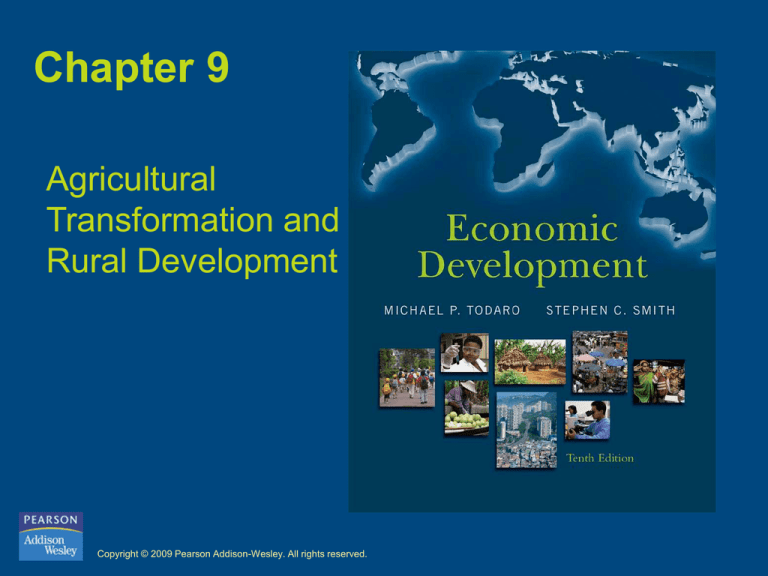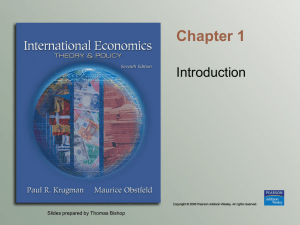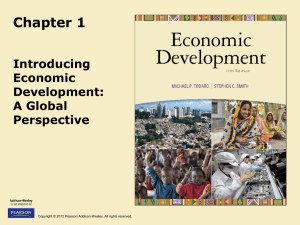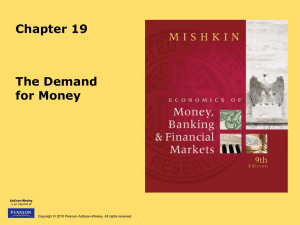
Chapter 9
Agricultural
Transformation and
Rural Development
Copyright © 2009 Pearson Addison-Wesley. All rights reserved.
Importance of Agricultural
and Rural Development
• Heavy emphasis in the past on rapid
industrialization at the expense of
agriculture
• Agricultural development is now seen
as an important part of any
development strategy
Copyright © 2009 Pearson Addison-Wesley. All rights reserved.
9-2
Contribution of Agriculture
• Produce
– food to meet basic nutritional needs of the
population
– raw materials to help the industry
– cash crops for export
• Farmers have demand for manufactured
consumer and capital goods
Copyright © 2009 Pearson Addison-Wesley. All rights reserved.
9-3
Contribution of Agriculture
• Agriculture employs a large percentage of
the labor force
• Agriculture generates a large percentage
of the GDP
• With improved farm productivity, the labor
and GDP shares of agriculture will decline
over time
Copyright © 2009 Pearson Addison-Wesley. All rights reserved.
9-4
Improved Farm Productivity
1960-2005
Copyright © 2009 Pearson Addison-Wesley. All rights reserved.
9-5
The Shares of Agriculture
Copyright © 2009 Pearson Addison-Wesley. All rights reserved.
9-6
Agraian Structures
• The structure of agrarian systems consists
of three types of countries:
– Agriculture-based countries
– Transforming countries
– Urbanized countries
Copyright © 2009 Pearson Addison-Wesley. All rights reserved.
9-7
Agraian Structures
Copyright © 2009 Pearson Addison-Wesley. All rights reserved.
9-8
Agricultural Dualism: World
MDCs have higher total factor productivity
than LDCs
• Land (output per acre)
• Labor (output per worker-hour)
• Capital (output per machine-hour)
• Appropriate technology
Copyright © 2009 Pearson Addison-Wesley. All rights reserved.
9-9
Land Productivity in Developed and
Developing Countries
Copyright © 2009 Pearson Addison-Wesley. All rights reserved.
9-10
Reasons for Poor Performance
Lack of investment in
• Human capital (education, nutrition, health)
• Social capital (roads, homes, electricity,
irrigation)
• Physical capital (mechanical inputs, storage
rooms)
• Technological advancement: (high yield
seed variety, better planting methods)
Copyright © 2009 Pearson Addison-Wesley. All rights reserved.
9-11
Reasons for Poor Performance
Unequal land distribution
– Large and powerful landowners
– Small family farmers and peasants
– Sharecroppers, landless peasants, and farm
workers
Copyright © 2009 Pearson Addison-Wesley. All rights reserved.
9-12
Agricultural Land Distribution
Copyright © 2009 Pearson Addison-Wesley. All rights reserved.
9-13
Agricultural Land Distribution
Copyright © 2009 Pearson Addison-Wesley. All rights reserved.
9-14
Agricultural Dualism: Latin America
Latifundios:
• Very large landholdings
• Commercial farming & advanced farm technology
• Employing more than 12 workers
Minifundios:
• Small family farms (a few workers)
• Subsistence farming & primitive technology
• Low standard of living
Copyright © 2009 Pearson Addison-Wesley. All rights reserved.
9-15
Agricultural Dualism: Latin America
Problems:
• Land concentration: 71.6% of land
owned by 1.3% of landowners
• Inefficiency of latifundios
• Subsistence of minifundios
Copyright © 2009 Pearson Addison-Wesley. All rights reserved.
9-16
Agricultural Dualism: Asia
Commercial farming:
• Very large landholdings
• Massive government subsidies
Subsistence farming:
• Small family farms
• Sharecroppers and landless peasants
• Little or no government support
Copyright © 2009 Pearson Addison-Wesley. All rights reserved.
9-17
Agricultural Dualism: Asia
• Colonial heritage of cash crop production
(e.g., cotton, peanuts)
• Progressive introduction of monetized
transactions
• Powerful “absentee” landowners residing in
large cities with political & economic
influence
Copyright © 2009 Pearson Addison-Wesley. All rights reserved.
9-18
Agricultural Dualism: Asia
• Moneylenders and loan sharks
– Lend money for buying seeds and fertilizer
– Charge exuberant interest rates (20-50%)
– Hold land as collateral
– Take over the land in case of loan default in
poor-crop years
– Become landowners themselves
Copyright © 2009 Pearson Addison-Wesley. All rights reserved.
9-19
Agricultural Dualism: Asia
Problems:
•
•
•
•
•
Poverty
Land and income disparity
Rapid population growth
Growing number of landless peasants
Lack of government programs helping small
farmers
• Massive R-U migration
Copyright © 2009 Pearson Addison-Wesley. All rights reserved.
9-20
Agricultural Dualism: Africa
Commercial farming:
• Very large landholdings
• Massive government subsidies
Subsistence farming:
•
•
•
•
Small family farms
Primitive technology
Large areas of unusable land
Massive underemployment, but labor shortage in
crop season
Copyright © 2009 Pearson Addison-Wesley. All rights reserved.
9-21
Agricultural Dualism: Africa
Problems:
•
•
•
•
Poverty
Land and income disparity
Rapid population growth
Lack of government programs helping
small farmers
• Massive R-U migration
• Rapid deforestation and desertification
Copyright © 2009 Pearson Addison-Wesley. All rights reserved.
9-22
Economic Role of Women
Daily tasks:
• Home-making and child rearing
• Food processing for consumption and
storage
• Farming: weeding, harvesting, raising
livestock
Copyright © 2009 Pearson Addison-Wesley. All rights reserved.
9-23
Economic Role of Women
• Cash crop labor
• Generate income through cottage industry
• Make up 60-80% of farm labor in Asia &
Africa; 40% in Latin America
• Are subject to gender discrimination in
education and employment
Copyright © 2009 Pearson Addison-Wesley. All rights reserved.
9-24
Risk Taking in Subsistence Farming
Minimum consumption requirement (MCR):
• Amount of food necessary for survival
• Fixed by nature
• Output below which means hunger and
starvation
Copyright © 2009 Pearson Addison-Wesley. All rights reserved.
9-25
Risk Taking in Subsistence Farming
Minimum desirable consumption level (MDCL):
• Amount of food desirable
• Increases over time with application of more
protein and sugar
Copyright © 2009 Pearson Addison-Wesley. All rights reserved.
9-26
Risk Taking in Subsistence Farming
Output/Consumption
MDCL
Farmer B welcomes change
Farmer A resists change
MCR
Time
Copyright © 2009 Pearson Addison-Wesley. All rights reserved.
9-27
Risk Taking in Subsistence Farming
• Farmer A producing a tad over MCR is risk
averter
• He is unwilling to risk survival by making a
change in traditional way of life and farming
• Crop failure is catastrophic
Copyright © 2009 Pearson Addison-Wesley. All rights reserved.
9-28
Risk Taking in Subsistence Farming
• Farmer B producing close to MDCL is risk
taker
• He is willing to try new methods of production
• Crop failure still provides the minimum food
requirement
Copyright © 2009 Pearson Addison-Wesley. All rights reserved.
9-29
Risk Taking in Subsistence Farming
• Farmer A resists change to maintain MCR;
he prefers production technique A with low
mean and low variance
• Farmer B welcomes change to produce
closer to MDCL; he prefers production
technique B with high mean and high
variance
Copyright © 2009 Pearson Addison-Wesley. All rights reserved.
9-30
Risk Taking in Subsistence Farming
Technique A: low mean, low variance
Technique B: high mean, high variance
Mean = 10 Mean = 12
Copyright © 2009 Pearson Addison-Wesley. All rights reserved.
9-31
Sharecropping & Efficiency
Supply of labor is fixed at WA and demand for labor is
the Value of Marginal Product, VMP
For a small landowner: WA = VMP for employment = LF
For a sharecropper: WA = 0.5 VMP for employment = LS
Here LS < LF as sharecroppers have less incentive to
• Apply inputs including labor, seeds, fertilizer
• Use modern farming techniques
• Produce maximum output
Copyright © 2009 Pearson Addison-Wesley. All rights reserved.
9-32
Sharecropping & Efficiency
Copyright © 2009 Pearson Addison-Wesley. All rights reserved.
9-33
Rural Development Strategies
Technological change and innovation:
• Modern mechanical and chemical inputs
• High-yield seed varieties
• Modern farming techniques
• Appropriate technology: labor-intensive
Copyright © 2009 Pearson Addison-Wesley. All rights reserved.
9-34
Expansion of Modern Inputs in the
Developing Regions
Copyright © 2009 Pearson Addison-Wesley. All rights reserved.
9-35
Rural Development
• Institutional and Pricing Policies
• Parity pricing: equalization of unit farm and
nonfarm prices
• Distribution systems and farmer cooperatives
Copyright © 2009 Pearson Addison-Wesley. All rights reserved.
9-36
Rural Development Strategies
Land Reform:
• Distribute fertile land between small farmers and
landless peasants
• Compensate owners for loss of land
• Provide supportive services to help increase
production
• Establish rural industries and jobs to curb R-U
migration
Copyright © 2009 Pearson Addison-Wesley. All rights reserved.
9-37







